Instructions for growing bagged cucumbers: from preparing materials to harvesting the finished crop
Only lazy summer residents do not grow cucumbers in their gardens. This healthy and popular vegetable is easy to care for. It grows successfully both in the garden beds and in greenhouses.
But few have heard of growing cucumbers in bags. We will analyze in detail the advantages of this method, the necessary conditions and step-by-step instructions for growing with a photo.
The content of the article
What is needed to grow bagged cucumbers
First, you need to remember that cucumbers do not like direct sunlight. Therefore, it is advisable to place them in shaded areas of the site, greenhouse, balcony or loggia.
To grow cucumbers in this way, you will need dense plastic bags or bags of sugar and flour (they are stronger) with a volume of 50 liters or more. In bags of smaller volume, the root system of the vegetable will be cramped.
Also take care of the irrigation system (you will need a hollow tube or hose) and support (a simple long stick and twine or another structure that is convenient for you).
For litter, prepare cut grass, straw or sawdust, humus and soil. We will use wood ash, superphosphate and potash fertilizers as additives. This set is enough to grow an excellent harvest of cucumbers in bags.
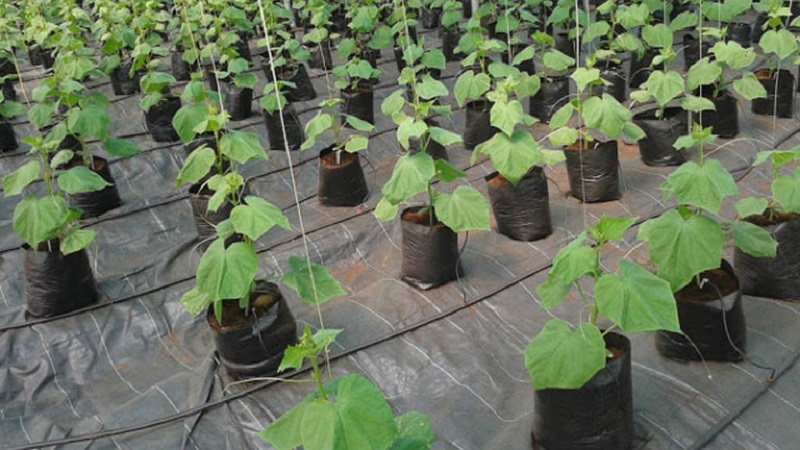
Which variety to choose
Biennial varieties of cucumber are perfect for growing in bags - they form more female flowers from which fruits are tied. So the harvest will be plentiful.
And to make fresh cucumbers happy all summer long, choose both early-ripening and late-ripening varieties, do not dwell on just one.
Step-by-step instruction
This method of planting cucumbers requires some effort during preparation, but it makes it easy to care for plants.
Seed preparation
Depending on your region, decide how you will plant seeds - directly into the ground or through seedlings. The first option is suitable if the temperature does not drop below 15 ° C, that is, for the southern regions of Russia or indoor cultivation. In other cases, it is necessary to plant seedlings in bags.
Before boarding seed it is necessary to prepare (they begin to do this already in April). To begin with, we warm them up: we place them in a cloth bag and hang them in a warm place (preferably above the battery) for several weeks. There is another way of warming the seeds that increases the number of fertile flowers. Pour water 60-65 ° C into a thermos, place seeds in it and leave to warm for 36-48 hours.
After warming up, the seeds must be calibrated. To do this, dissolve a large amount of table salt in warm water, where we place the seeds. For planting, we select only those that have sunk to the bottom. The pop-ups are deleted.
We wash the selected material and soak it in warm water for a day. After that, for a day, wet seeds in a napkin or cloth are placed in the refrigerator. The seeds are now ready to plant. Additionally, you can treat them with growth stimulants. Some gardeners advise pickling the seeds before planting.
For seedlings, we take peat or plastic cups, pour soil into 1/3 of the cup and plant one seed in each. As the plant grows, we add soil. We plant the shoots in bags after the appearance of the third leaf.
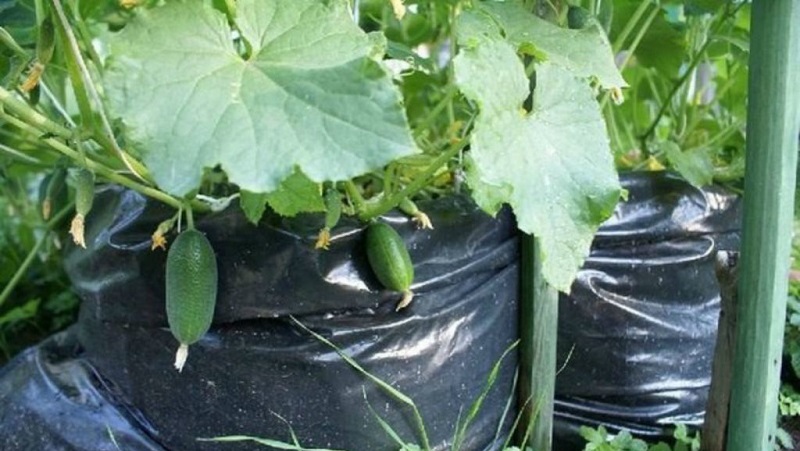
Site preparation
First, let's find a place to place the bags. On the street, we choose a shaded place and dig out small indentations for stability.On the balcony or loggia, we also free up a place protected from direct sunlight.
If you chose plastic bags for planting, for strength, use two bags at once, inserting one into the other. We make small holes in the bottom of the bag to ventilate the air and remove excess moisture. We cover the bottom with a layer of straw or sawdust.
Prepare the soil: mix 2 buckets of earth with a bucket of humus, two handfuls of wood ash, 20 g of superphosphate and 10 g of potash fertilizers. We fill the resulting soil into the bag to the middle. In the center we drive in a wooden support stick, and from it we take away the ropes or a net, to which our cucumber will cling in the future.
At a short distance from the stick in a circle, place three hollow tubes with holes in the ground. They will be needed when watering and feeding plants. After that, pour some more soil into the bag and wrap the edges of the bag, forming a side. We moisten the soil abundantly. Now you can plant cucumbers in the ground.
Landing
Sowing seeds or seedlings in bags should be when the air temperature stops dropping below 15 ° С... We plant 2-3 sprouts in each bag. If you want to increase the number of plants in each bag, you can make triangular holes in the sides of the bag and plant seeds or sprouts in them.
Important! Do not plant more than 15 cucumbers in one bag.
We plant cucumbers to a depth of 3-4 cm. When planting seeds, cover the bag with polyethylene or other covering material until the first shoots. If you are planting seedlings in bags, moisten the soil well in a glass and carefully remove the sprout along with a lump of earth. Place the plant in the soil in the bag directly with this ball.
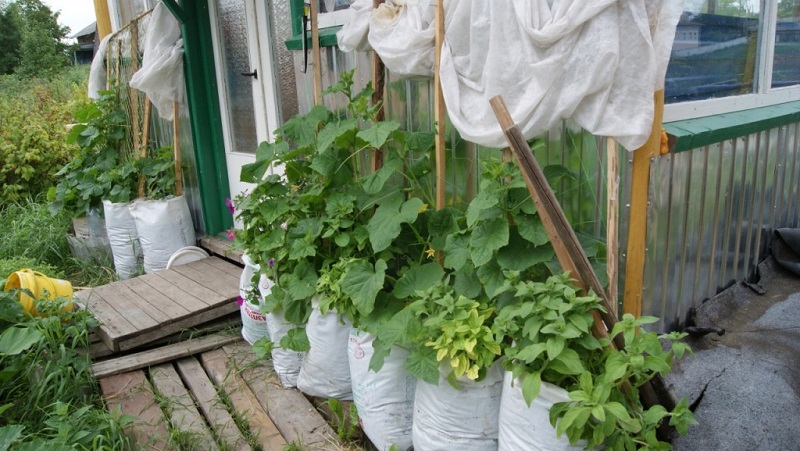
Care rules
Cucumbers love water, so you need to water them abundantly, and do not forget to spray. Watering is slightly reduced during flowering to form ovaries. As soon as the plant begins to bear fruit, it should be watered abundantly every day. In bags, the soil stays wet longer, watch this so as not to overmoisten it.
It is best to use hollow tubes with holes for irrigation, into which water comes from a hose or watering can. But especially lazy ones can simply water the plants from a bucket or watering can outside without using straws.
In addition to watering, plants need timely feeding... Top dressing can be done through the same hollow tubes for even distribution over the entire soil. Cucumbers are fed with both organic (chicken droppings, herbaceous infusion) and chemical fertilizers (superphosphate, potassium, nitrophoska).
The plants are fed 2-3 times a summer after watering. Cucumbers planted in this way practically do not need weeding, but if grass or weeds still germinate in the soil, it is better to remove them.
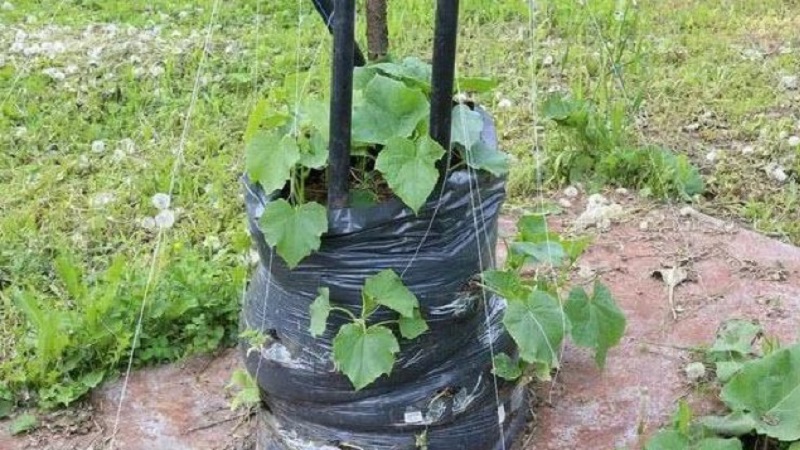
Possible problems and illnesses
When growing cucumbers in bags, gardeners face a number of problems. First, it is uniform watering. Since moisture remains in the bag longer, it is important not to ruin the plant by over-watering. At the same time, it is dangerous to dry the plant without giving it enough water.
Secondly, direct sunlight is dangerous for cucumbers. If you do not want to burn your plant, provide it with a shaded area with diffused sunlight.
Third, you don't need to plant too many plants in one bag. They simply do not have enough nutrients and moisture, they will grow weak and infertile.
This method of cultivation saves cucumbers from many diseases, protects against hypothermia and waterlogging of the soil.
But still, although less likely, the plant can get sick with powdery mildew, downy mildew, brown spot, white, gray and root rot. To combat these diseases, gardeners use various fungicides (Novosil, Topaz, Privent, etc.).
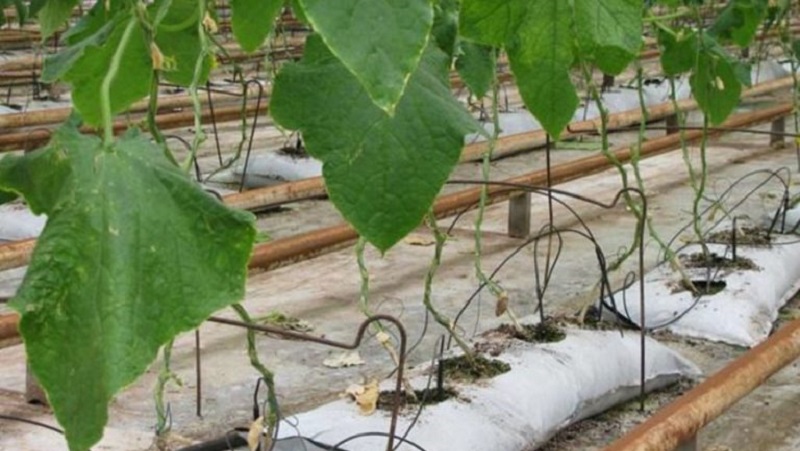
Harvesting
The time of appearance of the first fruits depends on the selected variety. As soon as you see the first cucumbers on the bushes, you can start harvesting.
The main rule of gardeners is timely, in the case of cucumbers - daily collection. This will help the plant to form new ovaries and maximize the yield possible.
If you have chosen a variety with predominantly female flowers, plant a cucumber with a large number of male flowers next to it for greater yield - this will speed up the pollination process.
Advantages and disadvantages of the method
Cucumbers in bags, and not in the garden, take up less space, which is especially important for summer residents with a small plot or those who decide to grow vegetables on the balcony. With this method, much less time and effort is spent on leaving.
Such a bed does not need weeding, is protected from pests and is often ventilated. Cucumbers grown in bags are always clean and bear fruit longer.
The disadvantages of this are related only to the need to maintain a stable temperature and humidity in the soil placed in the bag.
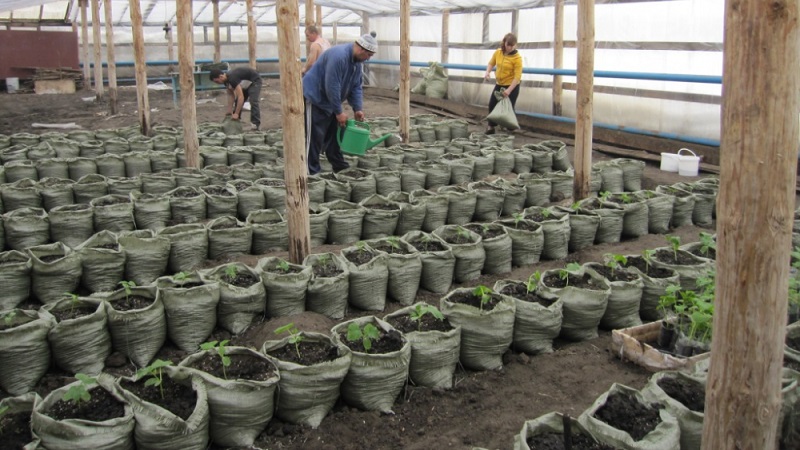
Advice and feedback from experienced gardeners
To get an excellent harvest of cucumbers, use the advice of experienced gardeners:
- plant cucumbers in tight bags;
- for stability, make grooves under the packages;
- do not overmoisten the soil;
- to harvest as long as possible, plant different varieties;
- Plant male plants near female plants for quick pollination.
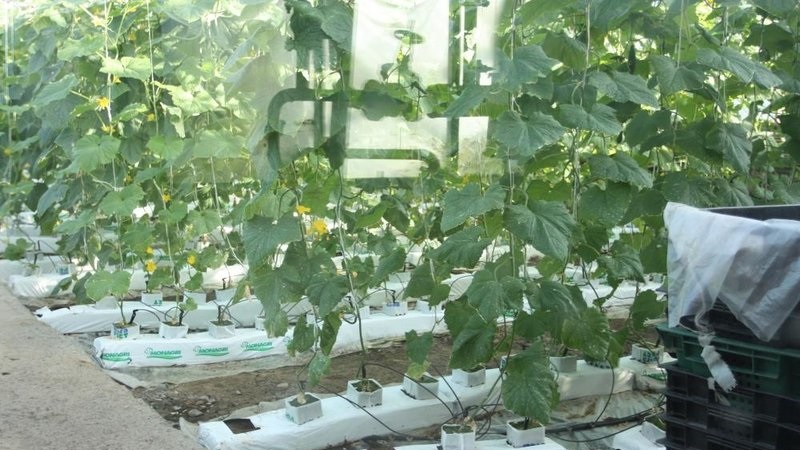
Several reviews from those who have successfully grown bagged cucumbers.
L. Maksimova, Votkinsk: “The cucumbers in sacks grew together, I watered them often, and then I look - they started to hurt. I walked around them and could not understand what they were missing? But it turned out - a lot of moisture! I made holes with a knife, a little time passed - and the cucumbers began to recover. In the summer, I soaked the grass for feeding vegetables, watered it, and put the not rotted grass in bags with cucumbers. There is warmth in the bag of the grasses, my cucumbers are warm. Such a beautiful hedge turned out! As a result of the experiment, there were a lot of cucumbers in the bags. This year I also want to plant zucchini in bags. Painfully, I liked the experience. "
Anna Kolomiets, Moscow: “I put a layer of freshly picked dandelions on the bottom of the bag under the straw and sawdust. Cucumbers in bags grow well and bear fruit. No trellises or stakes are needed to tie up the stem and side shoots, because there is a fence mesh nearby! I water the plants 2-3 times a week, feed them occasionally. To prevent moisture from evaporating strongly, I mulch the soil from above with mowed grass. This prevents crust formation and eliminates constant loosening. Plants are high from the ground, are well ventilated and therefore rarely get sick with root rot or other fungal diseases. Cucumbers bear fruit until mid-September. During this time, dandelions in bags are almost completely decomposed, the soil turns into humus, which is great for growing seedlings of tomato, pepper, eggplant. Film bags last about 5 years. "
Read also:
Instructions for growing bagged cucumbers: from preparing materials to harvesting the finished crop.
The best ways to pickle cucumbers for the winter with lemon.
Why do you need to process cucumbers with brilliant green and how to carry it out correctly.
Conclusion
Growing cucumbers in bags is a real godsend for those who do not want to plant beds in their garden, but want to be content with their own harvest. Follow all the rules of planting and caring for plants, and fresh cucumbers will not keep you waiting long.
If you don't feel like placing the bag vertically, just lay it on the ground and make cross-shaped slots. In such a bed, you will not find any weeds or pests. The main thing - do not forget about the support, it is necessary for cucumbers for proper growth. And if you want to make lightly salted cucumbers, choose smaller varieties.
Bon appetit and rich harvest!